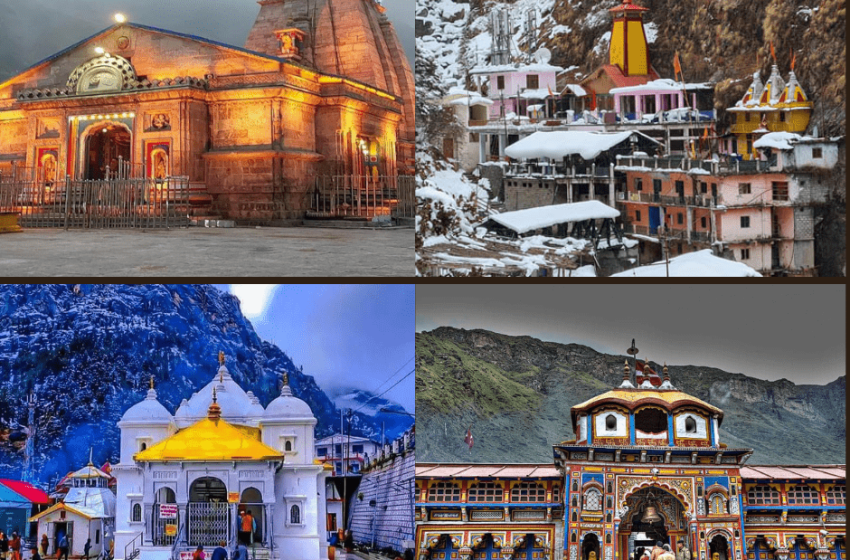The Chardham Yatra A Sacred Journey to the Abode of the Gods
- Business
 Samiksha dobhal
Samiksha dobhal- September 25, 2024
- 14

Chardham Yatra is one of India’s most revered pilgrimages, attracting thousands of devotees to the four sacred shrines: Yamunotri, Gangotri, Kedarnath, and Badrinath. Situated in the breathtaking Garhwal Himalayas, these temples represent the spiritual core of Hinduism and are believed to grant salvation to those who visit. Embarking on this journey is both a physical and spiritual challenge, providing a deep connection to nature, faith, and inner peace.
This article explores the spiritual significance, essential preparations, transportation options, and the profound religious practices associated with the Chardham Yatra.
The Spiritual Significance of the Chardham Yatra
The Chardham Yatra is believed to cleanse the soul and lead to moksha (liberation from the cycle of birth and death). Each dham (holy site) carries a distinct significance in Hindu mythology:
- Yamunotri is dedicated to Goddess Yamuna, the sister of Yama, the god of death. The river is said to wash away sins and protect devotees from an untimely death.
- Gangotri is the origin of the sacred River Ganga, where the goddess descended to Earth. Bathing in these holy waters is believed to purify the soul.
- Kedarnath is one of the twelve Jyotirlingas of Lord Shiva. It is said that visiting this temple can rid a person of their karmic debts, granting them eternal peace.
- Badrinath, dedicated to Lord Vishnu, is believed to be the ultimate pilgrimage site. A visit to this temple helps one attain spiritual prosperity and eternal liberation.
Together, these four temples form the spiritual circuit that every Hindu aspires to visit at least once in their lifetime.
How to Prepare for Chardham Yatra
The Chardham Yatra is physically demanding due to the high-altitude locations and challenging terrain. Proper preparation is key to ensuring a safe and fulfilling journey.
- Physical Fitness: Since trekking is involved, especially to Kedarnath and Yamunotri, building stamina through regular walking, cardio exercises, or yoga is highly recommended. Start preparing at least 4-6 weeks before the journey.
- Acclimatization: The temples are located at altitudes ranging from 3,300 to 3,800 meters. Spending a couple of days at a lower altitude, such as Rishikesh or Haridwar, can help the body adjust to higher altitudes, reducing the risk of altitude sickness.
- Packing Essentials: Pilgrims should carry warm clothing, as the weather in the mountains can change rapidly. Sturdy trekking shoes, a raincoat, a flashlight, and a first-aid kit are must-haves. Personal medications, energy snacks, and a power bank for gadgets are also important.
- Permits and Registration: The Uttarakhand government requires pilgrims to register for the yatra. You can do this online or at registration centers along the way. Carry valid ID proof, yatra registration slips, and other travel documents to avoid any last-minute hassles.
Best Transportation Options for Chardham Yatra
Reaching and traveling through the Chardham route requires meticulous planning, as the shrines are located in remote mountain regions. Here are some of the best transportation options:
- Air Travel: The nearest airport is Jolly Grant Airport in Dehradun, which connects well with major cities like Delhi and Mumbai. From Dehradun, taxis and buses are available to Haridwar and Rishikesh, the starting points for the yatra.
- Train Travel: The closest railway stations are in Haridwar and Rishikesh. Both stations are well-connected to major cities across India. From here, pilgrims can hire taxis or take buses to their respective destinations.
- Road Travel: Most pilgrims prefer road travel, either through private taxis or shared buses. Several government and private operators offer packages from Haridwar and Rishikesh, which cover all four dhams. Self-driving enthusiasts can also explore these routes, but caution is advised as roads in the mountains can be steep and narrow.
- Helicopter Services: For those who wish to avoid the long and arduous treks, helicopter services are available for Kedarnath and Badrinath. Several private operators run helicopter tours from Dehradun, Phata, and Guptkashi, making the journey more convenient, especially for the elderly and those with limited mobility.
Religious Practices and Rituals Associated with the Chardham Yatra
The Chardham Yatra is not just about visiting temples but also about participating in the age-old rituals that have been practiced for centuries. Each dham has its own set of customs, prayers, and offerings that pilgrims follow with devotion.
- Yamunotri: The pilgrimage to Yamunotri begins with a holy dip in the hot springs of Surya Kund. Pilgrims also offer prayers and cook rice in the thermal springs, which they carry home as prasad (holy offering).
- Gangotri: The temple at Gangotri is where pilgrims perform the Ganga Aarti, a spiritual ritual involving lamps and hymns, to honor the sacred River Ganga. Pilgrims often carry holy water from the river, believed to have healing properties, back to their homes.
- Kedarnath: The Kedarnath Temple is dedicated to Lord Shiva, and one of the most important rituals here is the Abhishek (ritual bathing) of the Shiva lingam with water from the Mandakini River. Many pilgrims also perform Pind Daan, a Hindu ritual for ancestors, which is believed to free the souls of the departed.
- Badrinath: Before entering the temple, pilgrims take a dip in the Tapt Kund, a hot spring near the temple. Devotees offer flowers, sweets, and prayers to Lord Vishnu, seeking his blessings for spiritual growth, prosperity, and protection.
These rituals create a deeply immersive spiritual experience for the pilgrims, leaving them with a sense of peace, fulfillment, and a stronger connection to their faith.
Challenges and Rewards of the Chardham Yatra
Undertaking the Chardham Yatra is not without its challenges. The journey requires both physical endurance and mental resilience. Treks to Kedarnath and Yamunotri can be particularly strenuous, and weather conditions are often unpredictable, with sudden rains or landslides being common.
However, the rewards of the journey far outweigh the difficulties. The breathtaking beauty of the Himalayas, the serene rivers, and the ancient temples provide a sense of tranquility and spiritual upliftment. Pilgrims often speak of the inner peace and divine energy they feel upon completing the yatra.
For many, the Chardham Yatra is a life-changing experience, allowing them to reflect on their spiritual journey, reconnect with their faith, and seek blessings for themselves and their families. It is not just a physical trek through the mountains but a metaphorical journey through life’s challenges, leading toward enlightenment and salvation.
Conclusion
The Chardham Yatra is a deeply spiritual pilgrimage that holds immense significance for Hindus worldwide. Whether you seek divine blessings, spiritual growth, or simply wish to experience the serene beauty of the Himalayas, this journey offers something for everyone. The yatra is a transformative experience that purifies the soul, strengthens faith, and brings one closer to attaining moksha. With proper planning and preparation, the Chardham Yatra can be a fulfilling and life-enriching journey, leaving lasting memories of devotion, perseverance, and inner peace.



